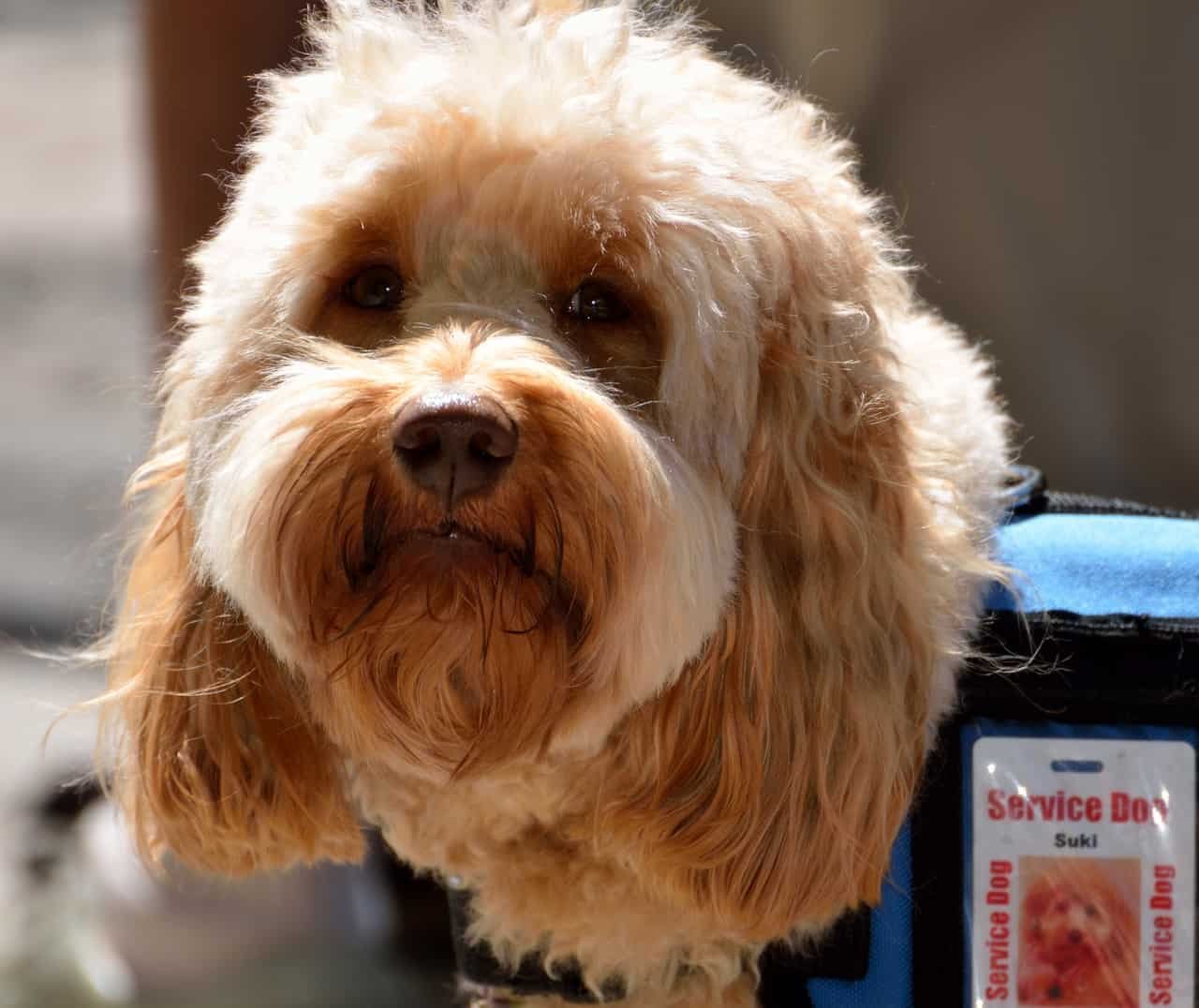Training your poodle to be a therapy dog can be a rewarding experience that benefits both you and your furry friend. Therapy dogs are trained to provide emotional support and comfort to individuals in various settings, such as hospitals, nursing homes, schools, and disaster areas. Poodles are a popular breed for therapy work due to their intelligence, hypoallergenic coat, and gentle temperament.
Key Takeaways
- Start training early for best results
- Positive reinforcement works best with poodles
- Consistency is more important than intensity
- Adjust techniques based on your poodle’s personality
To train your poodle to be a therapy dog, you will need to understand the requirements and responsibilities of therapy work, as well as the specific traits that make poodles well-suited for this role. You will also need to be patient, consistent, and dedicated to the training process. With the right guidance and approach, you can help your poodle become a valuable asset in your community, spreading joy and comfort to those in need.
Key Takeaways
- Poodles are a popular breed for therapy work due to their intelligence, hypoallergenic coat, and gentle temperament.
- To train your poodle to be a therapy dog, you will need to understand the requirements and responsibilities of therapy work, as well as the specific traits that make poodles well-suited for this role.
- With the right guidance and approach, you can help your poodle become a valuable asset in your community, spreading joy and comfort to those in need.
About This Guide
- Real Experience: Written by poodle enthusiasts with years of hands-on experience caring for and training poodles.
- Expert Reviewed: Content verified by certified dog trainers and veterinary professionals.
- Fact-Checked: Information sourced from the AKC, veterinary journals, and breed specialists.
- Last Updated: November 2025
Understanding Therapy Dogs
If you are considering training your poodle to be a therapy dog, it is important to understand what therapy dogs are and how they differ from other types of dogs, such as service dogs and emotional support animals.
Therapy dogs are trained to provide comfort and support to people in hospitals, nursing homes, schools, and other settings. They are not trained to perform specific tasks for individuals with disabilities, like service dogs are. Instead, therapy dogs are trained to provide emotional support and companionship to people who may be feeling lonely, anxious, or stressed.
One of the benefits of therapy dogs is their ability to improve mental health. Studies have shown that spending time with dogs can reduce symptoms of depression, anxiety, and post-traumatic stress disorder (PTSD). Therapy dogs can also help children with autism improve their social skills and reduce their anxiety.
It is important to note that therapy dogs are not the same as emotional support animals (ESAs). While therapy dogs are trained to provide comfort and support to others, ESAs are specifically designated to provide emotional support to their owners, who have been diagnosed with a mental health condition. ESAs are protected under the Americans with Disabilities Act, while therapy dogs are not.
If you are interested in training your poodle to be a therapy dog, there are a few things to keep in mind. First, your dog should have a calm and friendly temperament. They should be comfortable around people of all ages and be able to handle new and potentially stressful situations.
Second, your dog will need to undergo training to become a therapy dog. This training typically involves passing the American Kennel Club’s Canine Good Citizen test, which evaluates your dog’s obedience and manners. Your dog will also need to be trained to interact with people in a variety of settings, such as hospitals, nursing homes, and schools.
Overall, therapy dogs can provide valuable emotional support to people in a variety of settings. If you are interested in training your poodle to be a therapy dog, be sure to do your research and understand the training and certification requirements.
Why Poodles Make Good Therapy Dogs
If you’re looking for a dog breed to train as a therapy dog, poodles are an excellent choice. Their friendly and patient nature, combined with their love for people, makes them the perfect breed for this type of work.
Poodles are known for their calm temperament, intelligence, and personality. They are also highly trainable, which makes them an ideal candidate for therapy work. Poodles come in three different sizes: standard, miniature, and toy. While all sizes of poodles can make great therapy dogs, standard poodles are the most commonly used for this type of work.
Poodles are a breed that loves to please their owners. They are also highly social and love to be around people. This makes them a great choice for therapy work because they thrive on human interaction. Poodles are also very adaptable and can adjust to different environments easily.
In addition to their friendly and outgoing nature, poodles are also known for their intelligence. They are quick learners and can pick up new commands and behaviors easily. This makes them easy to train as therapy dogs.
Overall, poodles make excellent therapy dogs due to their friendly and patient nature, calm temperament, intelligence, and trainability. If you’re considering training your poodle to be a therapy dog, you won’t be disappointed.
Training Your Poodle for Therapy Work
Training your poodle to be a therapy dog requires a combination of basic obedience training, specialized training, and socialization. As a handler, you need to be patient, consistent, and committed to the process. The following tips will help you prepare your poodle for therapy work.
Basic Training
Before your poodle can become a therapy dog, they need to have basic obedience training. This includes commands like sit, stay, come, and heel. You can enroll your poodle in a training class or work with a professional dog trainer to help them learn these commands. Consistency is key when it comes to obedience training, so make sure to practice these commands regularly.
Specialized Training
In addition to basic obedience training, therapy dogs need specialized training to prepare them for their work. This includes training in areas like greeting strangers, remaining calm in public places, and responding to unexpected noises or movements. You can work with a professional dog trainer who specializes in therapy dog training to help your poodle develop these skills.
Socialization
Socialization is an essential part of training your poodle to be a therapy dog. This involves exposing your poodle to different people, animals, and environments to help them become comfortable in a variety of situations. Take your poodle to public places like parks, stores, and community events to help them socialize. Make sure to reward your poodle for good behavior and remain patient if they become anxious or nervous.
Exercise
Therapy dogs need to be in good physical condition to perform their work. Regular exercise can help keep your poodle healthy and happy. Take your poodle for daily walks, play fetch, or engage in other activities that will help them stay active.
Community Involvement
Becoming a therapy dog team requires involvement in your community. You can reach out to local hospitals, nursing homes, or schools to inquire about therapy dog programs in your area. Many organizations require therapy dogs to pass a certification test, such as the Canine Good Citizen test, before they can participate in therapy programs.
Training your poodle to be a therapy dog can be a rewarding experience for both you and your dog. With patience, consistency, and commitment, you can prepare your poodle for a fulfilling career as a therapy dog.
Certification and Testing
Once your poodle has completed their therapy dog training, it’s time to get them certified. Certification is the final step in the process of becoming a therapy dog, and it’s necessary for your dog to be recognized as a legitimate therapy dog.
To become certified, your poodle must pass an evaluation from a reputable national organization. The American Kennel Club (AKC) offers a certification program called the AKC Canine Good Citizen (CGC) test. This test evaluates your dog’s manners and obedience, and dogs that pass will receive a certificate.
To prepare for the CGC test, you may want to consider enrolling your poodle in a therapy dog training program. These programs can help your dog develop the skills necessary to pass the test.
During the CGC test, your poodle will be evaluated on the following ten skills:
- Accepting a friendly stranger
- Sitting politely for petting
- Appearance and grooming
- Walking on a loose leash
- Walking through a crowd
- Sit and down on command and staying in place
- Coming when called
- Reacting appropriately to another dog
- Reacting appropriately to distractions
- Supervised separation
If your poodle passes the CGC test, they will be recognized as a Canine Good Citizen and can move on to become a certified therapy dog.
Certification requirements vary depending on the organization, but most require that your dog completes a certain number of visits to hospitals, nursing homes, or other facilities. The AKC Therapy Dog Program, for example, requires that your dog completes at least 400 visits.
It’s important to note that certification is not a one-time event. Your poodle will need to be re-certified on a regular basis to maintain their status as a therapy dog. This ensures that they are still able to perform their duties and that they are up-to-date on their training.
The Role of a Therapy Dog Handler
As a therapy dog handler, your role is crucial in ensuring the success of therapy dog sessions. You are responsible for your dog’s behavior and interactions with the public, patients, and staff. Your tasks include training your poodle to be a therapy dog, preparing for therapy visits, and handling your dog during the visits.
One of the most important responsibilities of a therapy dog handler is to ensure that their dog is well-behaved and trained to handle different situations. A well-trained therapy dog can help patients feel more comfortable and relaxed, which can aid in their recovery. Handlers must also ensure that their dog is up-to-date on all vaccinations and has passed a health screening before participating in therapy visits.
Handlers must also prepare for therapy visits by researching the facility they will be visiting and understanding the goals of the therapy program. This can help them tailor their approach and interactions with patients and staff. It is also important for handlers to bring necessary items, such as water, treats, and a leash, to the therapy visit.
During the therapy visit, the handler is responsible for managing their dog’s behavior and interactions with patients and staff. Handlers must be attentive to their dog’s body language and signals to ensure that their dog is comfortable and not stressed. They must also be aware of the patients’ needs and emotions, and adjust their approach accordingly.
In summary, a therapy dog handler plays a crucial role in ensuring the success of therapy dog sessions. They are responsible for training their dog, preparing for therapy visits, and handling their dog during the visits. By being attentive to their dog’s behavior and interactions with patients and staff, handlers can help create a positive and beneficial experience for all involved.
Therapy Dogs in Different Settings
Therapy dogs can provide comfort, companionship, and emotional support to people in a variety of settings. These settings can include hospitals, nursing homes, schools, public access areas, institutions, airports, hospice, and housing. Each setting presents unique challenges and requirements for therapy dogs and their handlers.
Hospitals and Nursing Homes
Therapy dogs can be a valuable asset in hospitals and nursing homes. They can help patients feel less lonely and anxious, and can even help lower blood pressure and reduce pain. However, therapy dogs must be well-trained and have good hygiene practices to prevent the spread of infection. Handlers must also be sensitive to the needs of patients and staff, and be able to navigate medical equipment and procedures.
Schools
Therapy dogs can also be used in schools to help students with special needs or emotional issues. They can provide a calming presence and help students feel more comfortable and focused. However, handlers must be aware of school policies and regulations, and ensure that the dog is well-behaved and not disruptive to the learning environment.
Public Access Areas
Therapy dogs can also be used in public access areas, such as shopping malls or airports, to provide comfort and support to people who may be anxious or stressed. However, handlers must be aware of local laws and regulations regarding service animals, and ensure that the dog is well-behaved and not disruptive to others.
Institutions
Therapy dogs can also be used in institutions, such as prisons or mental health facilities, to provide emotional support to inmates or patients. However, handlers must be aware of the unique challenges and requirements of each institution, and ensure that the dog is well-trained and not disruptive to the environment.
Hospice and Housing
Therapy dogs can also be used in hospice and housing facilities to provide companionship and emotional support to residents. However, handlers must be aware of the unique needs and sensitivities of residents, and ensure that the dog is well-trained and not disruptive to the environment.
In conclusion, therapy dogs can be a valuable asset in a variety of settings, but it is important for handlers to be aware of the unique challenges and requirements of each setting. With proper training and sensitivity, therapy dogs can provide comfort and support to people in need.
Benefits of Therapy Dogs
Therapy dogs are trained to provide comfort, emotional support, and physical benefits to people in various settings. They can help lower blood pressure, reduce anxiety, and increase levels of endorphins and oxytocin. These dogs are trained to interact with people in a calm and friendly manner, providing a sense of comfort and security.
One of the most significant benefits of therapy dogs is their ability to provide emotional support. They can help people who are experiencing stress, anxiety, or depression. Therapy dogs can also provide a sense of comfort to people who are going through difficult times, such as those who have lost a loved one or are dealing with a serious illness.
Studies have shown that therapy dogs can help lower blood pressure and heart rate. This is especially important for people who are dealing with high levels of stress, such as those who are recovering from surgery or dealing with chronic pain. Therapy dogs can also help increase levels of endorphins and oxytocin, which can improve mood and reduce stress levels.
In addition to providing emotional support, therapy dogs can also provide physical benefits. They can help people who are recovering from injuries or illnesses by encouraging them to be more active. Therapy dogs can also help people who are dealing with mobility issues by providing support and assistance.
Therapy dogs are also great conversation starters. They can help people who are feeling isolated or lonely by providing a friendly and non-judgmental presence. Therapy dogs can also help children who are struggling with social skills by providing a safe and supportive environment for them to interact with others.
Overall, therapy dogs can provide a wide range of benefits to people in various settings. They can help improve emotional well-being, provide physical support, and encourage social interaction. If you are interested in training your poodle to be a therapy dog, there are many resources available to help you get started.
Therapy Dog Organizations
If you’re interested in training your poodle to be a therapy dog, it’s important to know about the various organizations that certify and register therapy dogs. These organizations provide guidelines and training for both dogs and handlers, as well as opportunities for volunteering and working with therapy dogs.
Therapy Dogs International
Therapy Dogs International (TDI) is a non-profit organization that registers and certifies therapy dogs and their handlers. TDI requires that dogs pass a temperament evaluation and that handlers complete a training course. Once certified, TDI therapy dogs and their handlers can visit hospitals, nursing homes, and other facilities to help improve the lives of those they visit.
AKC Therapy Dog Program
The American Kennel Club (AKC) also offers a therapy dog program. The AKC Therapy Dog Program certifies dogs that have completed basic obedience training and have passed a temperament evaluation. Once certified, AKC therapy dogs and their handlers can volunteer in a variety of settings, including schools, hospitals, and nursing homes.
Volunteering with Your Therapy Dog
Once your poodle is certified as a therapy dog, there are many opportunities to volunteer in your community. You can visit hospitals, nursing homes, schools, and other facilities to provide comfort and companionship to those in need. Many therapy dog organizations can help connect you with local facilities in need of therapy dog visits.
Rescue Dogs as Therapy Dogs
It’s important to note that rescue dogs can also make great therapy dogs. Many therapy dog organizations accept rescue dogs as long as they pass temperament evaluations and training courses. If you have a rescue poodle that you think would make a good therapy dog, consider contacting a therapy dog organization to explore your options.
In summary, becoming a therapy dog team can be a rewarding experience for both you and your poodle. By working with a therapy dog organization, you can ensure that your dog is properly trained and certified, and can make a positive impact on the lives of those in your community.
Legal Rights and Considerations
As a therapy dog owner, you have certain legal rights and considerations that you should be aware of. These rights and considerations can vary depending on the location and context in which you and your dog are providing therapy services.
Americans with Disabilities Act
Under the Americans with Disabilities Act (ADA), therapy dogs are considered service animals. This means that they are allowed to accompany their owners in public places, including restaurants, hotels, and other businesses. However, it’s important to note that therapy dogs are not granted the same rights as service dogs, which are trained to perform specific tasks for individuals with disabilities.
Public Places
While therapy dogs are allowed in public places under the ADA, it’s important to remember that not all public places are required to allow therapy dogs. For example, some hospitals and medical facilities may have their own policies regarding therapy dogs, and it’s always best to check with the facility before bringing your dog.
Housing
If you live in rental housing, you may be able to keep a therapy dog even if your landlord has a “no pets” policy. Under the Fair Housing Act, individuals with disabilities are allowed to keep service animals, including therapy dogs, in their homes. However, it’s important to note that landlords may require documentation from a healthcare provider verifying that the individual has a disability and that the therapy dog is necessary to provide emotional support.
Overall, it’s important to be aware of your legal rights and considerations as a therapy dog owner. By understanding these rights and considerations, you can ensure that you and your dog are able to provide therapy services safely and effectively.
Important Tips for Training
Training your poodle to be a therapy dog takes time, effort, and patience. However, with the right approach, you can help your poodle become a loving, well-behaved, and obedient therapy dog. Here are some important tips to keep in mind when training your poodle to be a therapy dog.
Consistency is Key
Consistency is essential when training your poodle. You should use the same commands and approaches every time you train your dog. This will help your poodle learn faster and avoid confusion. Make sure that everyone who interacts with your poodle uses the same commands and methods.
Positive Reinforcement
Positive reinforcement is a powerful training tool. Reward your poodle with treats, praise, and affection when they perform a desired behavior. Avoid using punishment or negative reinforcement, as this can damage the bond between you and your dog.
Obedience Training
Obedience training is the foundation of therapy dog training. Your poodle should be able to follow basic commands such as sit, stay, come, and heel. Consider enrolling your poodle in a basic obedience class or work with a professional trainer to ensure that your poodle has a solid foundation in obedience training.
Socialization
Socialization is crucial for therapy dogs. Your poodle should be comfortable around people of all ages, sizes, and backgrounds. Introduce your poodle to different environments, such as parks, schools, and nursing homes. This will help your poodle become more comfortable and confident in new situations.
Exercise
Exercise is essential for your poodle’s physical and mental health. Make sure that your poodle gets enough exercise every day. This will help your poodle stay calm, focused, and happy. Consider taking your poodle for daily walks or runs, playing fetch, or participating in agility training.
Community Involvement
Community involvement is a great way to help your poodle become a therapy dog. Consider volunteering at a local hospital, nursing home, or school with your poodle. This will help your poodle get used to different people and environments, and it will also give you a chance to practice your poodle’s therapy dog skills.
By following these tips, you can help your poodle become a successful therapy dog. Remember to be patient, consistent, and positive in your approach. With time and effort, your poodle can make a positive impact on the lives of others as a therapy dog.
Common Challenges and Solutions
Training your poodle to be a therapy dog can be a fulfilling experience, but it is not without its challenges. Here are some common challenges you may encounter and solutions to overcome them.
Challenge: Fear and Anxiety
Some dogs may feel anxious or fearful in new environments or around new people. This can make it difficult for them to perform their duties as a therapy dog.
Solution: Socialization and Exposure
Proper socialization and exposure to new people, environments, and situations can help your poodle feel more comfortable and confident. Take your poodle to different places and introduce them to new people and animals. Reward them for their good behavior and positive interactions.
Challenge: Stress and PTSD
Therapy dogs may be exposed to stressful situations or encounter individuals with post-traumatic stress disorder (PTSD).
Solution: Specialized Training
Consider specialized training for your poodle to prepare them for these situations. Look for training programs that focus on stress reduction and PTSD support. It is important to ensure that your poodle is comfortable and prepared to handle these situations before they begin their therapy work.
Challenge: Depression and Autism
Individuals with depression or autism may benefit from the companionship and emotional support of a therapy dog. However, it can be challenging for a therapy dog to connect with these individuals.
Solution: Patience and Understanding
It is important to be patient and understanding when working with individuals with depression or autism. Allow your poodle to approach these individuals at their own pace, and provide them with positive reinforcement for their interactions. Consider working with a therapist or specialist who can provide guidance on how to best support these individuals.
Training your poodle to be a therapy dog requires patience, dedication, and a willingness to overcome challenges. By addressing these common challenges and implementing effective solutions, you can help your poodle become a successful therapy dog and make a positive impact on the lives of others.
Conclusion
Training your poodle to be a therapy dog can be a rewarding experience for both you and your furry friend. By following the steps outlined in this article, you can help your poodle become a valuable asset in providing comfort and support to those in need.
Remember, therapy dogs must possess certain qualities such as obedience, calmness, and a friendly demeanor. It is important to start training your poodle early on to ensure they develop these traits. Positive reinforcement techniques such as treats and praise can be effective in encouraging good behavior.
During the training process, it is important to socialize your poodle to different environments and situations. This will help them become comfortable in a variety of settings and be better equipped to handle the demands of therapy work.
Once your poodle is trained and certified as a therapy dog, there are many opportunities to volunteer with hospitals, nursing homes, and other institutions. Your poodle can provide much-needed comfort and companionship to those who may be feeling lonely or anxious.
Overall, training your poodle to be a therapy dog requires patience, dedication, and a love for helping others. With the right training and temperament, your poodle can make a positive impact on the lives of many people.
Frequently Asked Questions
If you’re considering training your poodle to become a therapy dog, you may have some questions about the process. Here are some frequently asked questions about therapy dogs and their training:
What breeds are best for therapy dog work?
While any breed can become a therapy dog, some breeds are more commonly used due to their friendly and calm nature. Breeds like Golden Retrievers, Labradors, Poodles, and Cavalier King Charles Spaniels are often used as therapy dogs due to their gentle dispositions and intelligence.
How can I train my dog to be a therapy dog?
Training your dog to become a therapy dog involves teaching them basic obedience skills, such as sit, stay, and come, as well as socialization skills, like being comfortable around strangers and other animals. You can enroll your dog in a therapy dog training program or work with a professional trainer to develop the necessary skills.
What is involved in therapy dog certification?
Therapy dog certification involves passing a series of tests that assess the dog’s temperament, obedience, and socialization skills. The tests are typically administered by a therapy dog organization, and once the dog passes, they will receive certification and be eligible to participate in therapy dog programs.
What are the responsibilities of a therapy dog handler?
As a therapy dog handler, your responsibilities include ensuring that your dog is well-behaved and trained, following the rules and regulations of the therapy dog organization, and providing emotional support to the people you visit with your dog. You may also be responsible for maintaining records and documentation related to your dog’s visits.
How old should a dog be before starting therapy dog training?
Dogs should be at least one year old before starting therapy dog training. This is because younger dogs may not have developed the necessary socialization and obedience skills to be effective therapy dogs.
Do therapy dogs receive compensation for their work?
Therapy dogs do not typically receive compensation for their work. They are trained to provide emotional support and companionship to people in need, and their handlers volunteer their time and resources to participate in therapy dog programs.
While any breed can become a therapy dog, some breeds are more commonly used due to their friendly and calm nature. Breeds like Golden Retrievers, Labradors, Poodles, and Cavalier King Charles Spaniels are often used as therapy dogs due to their gentle dispositions and intelligence.
“}},{“@type”:”Question”,”name”:”How can I train my dog to be a therapy dog?”,”acceptedAnswer”:{“@type”:”Answer”,”text”:”
Training your dog to become a therapy dog involves teaching them basic obedience skills, such as sit, stay, and come, as well as socialization skills, like being comfortable around strangers and other animals. You can enroll your dog in a therapy dog training program or work with a professional trainer to develop the necessary skills.
“}},{“@type”:”Question”,”name”:”What is involved in therapy dog certification?”,”acceptedAnswer”:{“@type”:”Answer”,”text”:”
Therapy dog certification involves passing a series of tests that assess the dog’s temperament, obedience, and socialization skills. The tests are typically administered by a therapy dog organization, and once the dog passes, they will receive certification and be eligible to participate in therapy dog programs.
“}},{“@type”:”Question”,”name”:”What are the responsibilities of a therapy dog handler?”,”acceptedAnswer”:{“@type”:”Answer”,”text”:”
As a therapy dog handler, your responsibilities include ensuring that your dog is well-behaved and trained, following the rules and regulations of the therapy dog organization, and providing emotional support to the people you visit with your dog. You may also be responsible for maintaining records and documentation related to your dog’s visits.
“}},{“@type”:”Question”,”name”:”How old should a dog be before starting therapy dog training?”,”acceptedAnswer”:{“@type”:”Answer”,”text”:”
Dogs should be at least one year old before starting therapy dog training. This is because younger dogs may not have developed the necessary socialization and obedience skills to be effective therapy dogs.
“}},{“@type”:”Question”,”name”:”Do therapy dogs receive compensation for their work?”,”acceptedAnswer”:{“@type”:”Answer”,”text”:”
Therapy dogs do not typically receive compensation for their work. They are trained to provide emotional support and companionship to people in need, and their handlers volunteer their time and resources to participate in therapy dog programs.
“}}]}





